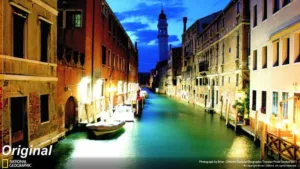There is a company you’ve probably never heard of whose display technology sits inside a million notebook PCs. Entertainment Experience LLC has developed a total color management system whose mathematical and vision models are embedded in multidimensional look-up tables (LUTs). Current customers include Dell and Quanta, the world’s largest notebook PC ODM.

This week, I spoke separately with CEO John Parkinson and the technology’s inventor and developer Jim Sullivan.
When the image captured by a typical professional video camera is re-mapped to Rec.709, at least 70% of the color information is thrown away, Sullivan said. One example: grass green and laser green map to the same RGB values. All the energy that goes into maintaining color fidelity is applied only to that reduced gamut and does not address the loss of perceived fidelity that was inflicted early in the process. Part of what EE LLCs software product, eeColor, does is to compensate for that loss in perceived fidelity by intentionally breaking away from “hardware fidelity”. Parkinson noted that the software recomputes the values for each pixel in the frame individually in real time.
Most natural colors only occupy the central portion of the display’s color space. eeColor expands this portion to more completely fill the color space of the display. But memory colors, such as skin and sky, are displayed without modification. Doing this blindly would result in “memory colors,” such as skin and sky, becoming distorted. eeColor identifies the range of color coordinates that include these memory colors and preserves the color values of these pixels as the overall gamut is expanded. EE LLC calls these patches of preserved color coordinates “filters”.
eeColor incorporates models of skin tone developed at the Rochester Institute of Technology and uses them to maintain skin tone under brightness changes and color remapping. Different skin tones, from African to Scandinavian, are mostly a matter of brightness rather than color shift. But there are cultural preferences. Asians seem to like displays to show skin tones a bit more blue than do Americans and Europeans. This is addressed with slide bar in the UI.
Sullivan said that engineering the filters was the toughest part of the job. There are times when the color space is remapped that the skin-tone vector (for example) must move in the opposite direction for the image vector for the overall scene. Strange things can happen at the boundaries of these filters with the overall display color space.
At EE LLC, the company uses “colorfulness” to describe the color content of a frame. This is the volume of colors contained in the 3D volume of the IPT color space. Percent of NTSC, which the hardware people have been trained to use, “is useless”.
The company uses the IPT color space because it preserves hue and brightness under gamut mapping. Moving the color portion (PT) of the vector maintains the perceived brightness (I). CIELAB can’t do this, nor does RGB, Sullivan said.
The vision model used by eeColor allows the viewer to observe rec.709 imagery in a relatively bright home or office environment and see the colors as they would appear in darkened cinema. The adaptive color boost is working with the behavior of the human visual system.
eeColor’s “management produces greater brightness with the same power, while keeping color quality”, Sullivan said. It is therefore very attractive for battery-operated devices.
The transformations performed by eeColor affect color only. For a complete solution, eeColor needed to handle sharpness and contrast, as well. For this it teamed up with Razzor Technologies, an RIT spin-off. Razzor’s approach also uses LUTs, so it was possible to combine the two sets of technologies into a single software product. Razzor’s sharpening technology avoids the white fringe that convolution filters impose on sharpened edges.
The company’s approach allows every input color to be mapped to an output color based on sound visual models, which has interesting applications. Among these is the ability to adjust for unit-to-unit variations in color rendition, and also to allow product manufacturers to compensate for the color differences between panels from different manufacturers.
The company has also worked with LG Display to minimize use of the blue phosphor and thus retard blue-phosphor aging.
These functions can be implemented in hardware, but Sullivan says EE LLC’s licensing fee per unit is less than the $3.00 unit cost (in volume) of a popular graphics co-processor. And with current personal devices having processing power to spare, EE LLC believes that software is the way to go. (The folks at Pixelworks may disagree.)
eeColor is currently available for the Microsoft and Android OS’s running on the most popular chips. – Ken Werner

